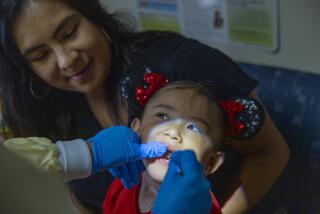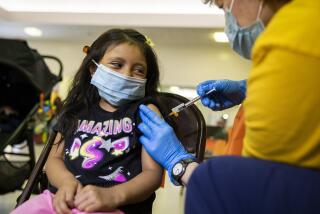New Vaccine Combats Ear Infections Too
- Share via
Dillon White’s first ear infection arrived at the tender age of 6 months. And what followed is an all-too-familiar story in many families: repeated earaches. By age 2, Dillon had surgery to insert tubes in his ears to drain fluid and reduce the breeding ground for infections.
“I was in the medical office building every month from age 6 months on getting antibiotics,” said Dillon’s mother, Gayle White. “I did not want him to have surgery. But we had tried everything else.”
Although it is rarely dangerous, perhaps no disease inflicts more misery on young children and their parents than ear infections, or otitis media, as it is known in medical terms. But for the Whites and other parents, help is in sight.
A new vaccine is expected to be approved later this year for serious childhood infections, such as meningitis, but which has the added benefit of reducing some cases of ear infections.
A study released last week found that the vaccine reduced the number of new ear infections by 7%. Researchers estimated that the vaccine could eliminate 2 million doctor visits annually at a savings of several hundred million dollars of medical visits and parents’ lost time from work.
Up to 95% of kids experience at least one bout of otitis media by age 6, and several million each year battle chronic infections that can lead to aggressive antibiotic regimens, surgery and great distress to families.
“We’re talking about a major disease that causes a great deal of distress in children,” said Dr. Henry Shinefield, who conducted the study with Dr. Steven Black of the Kaiser Permanente Vaccine Study Center.
Even curbing ear infections by that margin could create an additional benefit in cutting the use of antibiotics, says Dr. Cynthia Whitney, an epidemiologist at the Centers for Disease Control and Prevention. Health officials say that pneumococcus and other bacteria are becoming increasingly resistant to existing antibiotics due to overuse and misuse.
“Otitis media is probably the most common reason kids get antibiotics. If we can reduce antibiotic use in that group, we can maybe reduce the amount of antibiotic resistance we see now,” she said.
*
The primary goal of the pneumococcal vaccine, however, is not to stop ear infections. The vaccine protects against seven of the most destructive strains of the bacterium Streptococcus pneumoniae, which is the scientific name for pneumococcus. Pneumococcus is largely responsible for meningitis and bacteremia in children, and, to a lesser extent, pneumonia, otitis media and sinusitis.
Research released last fall showed the vaccine is 100% effective in preventing meningitis and bacteremia, both serious bloodstream infections that in rare instances can cause death. The three-year study followed 38,000 children treated at Kaiser Permanente clinics in Northern California.
The ear infection data released last week at the Pediatric Academic Societies meeting in San Francisco examined the same group of children. Half of the babies received the vaccine and half received a placebo (shots containing a harmless, ineffective solution). Pediatricians were not told which group their patients were assigned to.
The results showed that out of 47,000 doctor visits due to otitis media over the three years, there were 7% fewer new cases of the disease and 8.9% fewer doctor visits in the vaccine group.
“The invasive-disease [meningitis and bacteremia] data is very impressive. But the otitis media data is also exciting because it’s something we weren’t sure about,” said Peter Paradiso, vice president of scientific affairs and research strategy at Wyeth Lederle Vaccines, which developed the vaccine.
*
Researchers knew that the vaccine could produce antibodies that would protect against bloodstream infections like meningitis, Paradiso said. “But whether enough antibody could get into the ear to have an effect was something we didn’t know.”
Only about 40% of pediatric ear infections are caused by pneumococcus. The Kaiser study did not distinguish between ear infections caused by pneumococcus and those caused by other bacteria and viruses. A study underway in Finland is designed to look at the vaccine’s effectiveness on only otitis media caused by pneumococcus.
Wyeth Lederle is already working on an improved version of the vaccine that would target additional types of bacteria that cause ear infections, Paradiso said.
The vaccine, though, already seems to work best in the children who need it the most. The vaccine group was 20.3% less likely to require ear tubes and 22.8% less likely to have frequent ear infections (defined as five bouts in six months or six bouts in 12 months). Vaccinated children also were 65% less likely to have a ruptured eardrum.
“It’s more likely that recurrent infections are caused by Strep pneumoniae. For the subset of children who need ear tubes and have severe disease, it’s going to help them even more,” Whitney said.
The vaccine also appears to be very safe. Data on 20,000 children show no serious side effects, Paradiso said. Children, however, may experience muscle soreness and mild fever from the shot.
Gayle White, who lives in Walnut with her husband, Maurice, said she will be asking her pediatrician about the vaccine when it is approved. While it is expected to be recommended as a routine vaccine given at 2, 4 and 6 months, with booster shots at 12 and 15 months, children under age 5 with chronic ear infections appear to benefit as well, Paradiso said.
“I would jump at the chance of having a vaccine,” White said. Dillon, now 3, had tests after his ear surgery that showed he had not been hearing properly and that his speech was delayed. “If we would have had this, it might have kept me from having a lot of sleepless nights.”
(BEGIN TEXT OF INFOBOX / INFOGRAPHIC)
Ear
An ear infection occurs when germs from the nose and throat begin to multiply in the inner ear, between the eardrum and the bones of the inner ear.
The eustachian tube connects the middle ear to the back of the throat. In children, the tube is short and narrow and becomes easily blocked, trapping germs in the middle ear.






